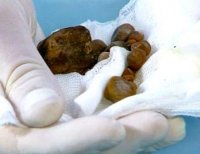Gall stones
Overview
Usually, gallstones also called cholelithiasis, cholelithiasis. Gall bladder bag-shaped organ located in front of the liver, is a reservoir for the liquid bile, which is produced in the liver and is involved in the digestion of fats. Gallstones are formed from cholesterol crystals or less of bile salts. Stones can be as small as a grain of sand, or large, the size of a walnut.
Cholecystitis or biliary colic, is observed when the stone is located in the gallbladder, bile duct clogs by which bile comes from the gallbladder to the small intestine.
Causes cholelithiasis
It is believed that the stones are formed due to the imbalance of substances, out of which a bile. Certain value also has a high content of cholesterol in bile. The attack of gallstone disease is often triggered by abundant fatty foods.
Symptoms of gallstones
Often biliary colic resolves on its own. When the stone passes through the bile duct into the small intestine, pain and other symptoms disappear. If the stone is so great that it can not move, the pain continues, and in such cases require immediate surgical intervention. If the stone is retained in the common bile duct, by which the flow of bile from the liver and gallbladder, it may develop jaundice (yellow coloring of the skin and sclera), and possible liver damage.
Complications in the presence of gallstones
Most gallstones are not dangerous to anyone until a blockage of the bile duct stone, which contributes to the accession of infection and the development of inflammation of the gallbladder, liver and pancreas. gall bladder rupture can lead to peritonitis. Chronic gallstone disease is also associated with an increased risk of gallbladder cancer.
What you can do
During an attack of pain should go, do not eat, take for pain relief can be taken analgesics. If an attack of biliary colic lasts more than 2 hours, be sure to seek medical help. If you often have pain or discomfort in the right upper quadrant, should consult a doctor.
What can a doctor
Gallstones are usually diagnosed mainly by X-ray and ultrasound.
Many stones are "silent", without causing any symptoms. In such cases, the treatment is usually not required. If you develop pain attack is usually recommended cholecystectomy (removal of the gallbladder surgically). In some cases, prescribers, dissolving gallstones. However, these drugs should be taken several years to completely dissolve the stones and create conditions that will prevent the development of new stones.
Preventing the formation of gallstones
To avoid the formation of gallstones should:
- In the presence of excess body weight to apply a low-calorie diet and exercise to body weight gradually reduced;
- Avoid rich food with a high fat diet;
- Detection of gallstones women should avoid the treatment of estrogen, which can promote the formation of gallstones;
- Should reduce the intake of cholesterol.

